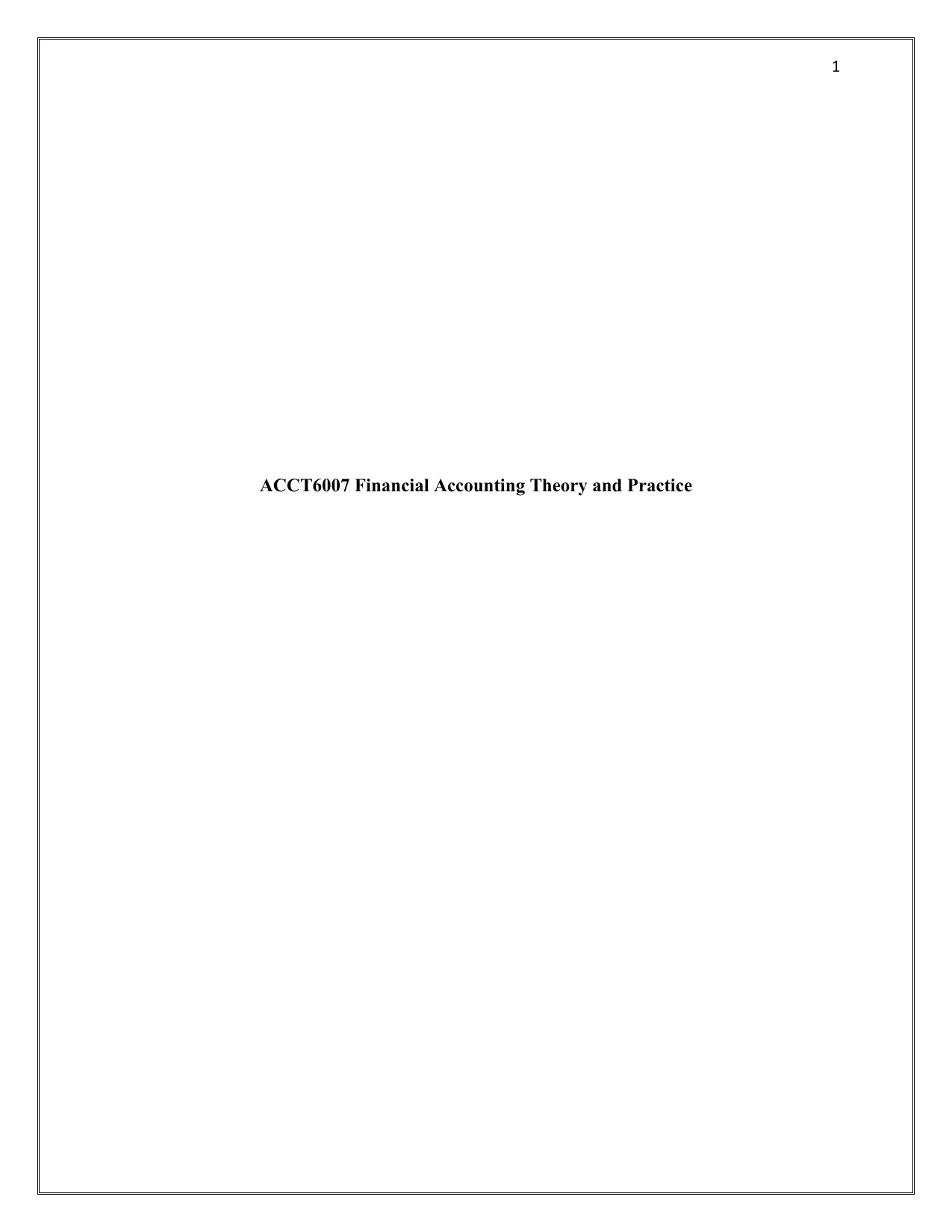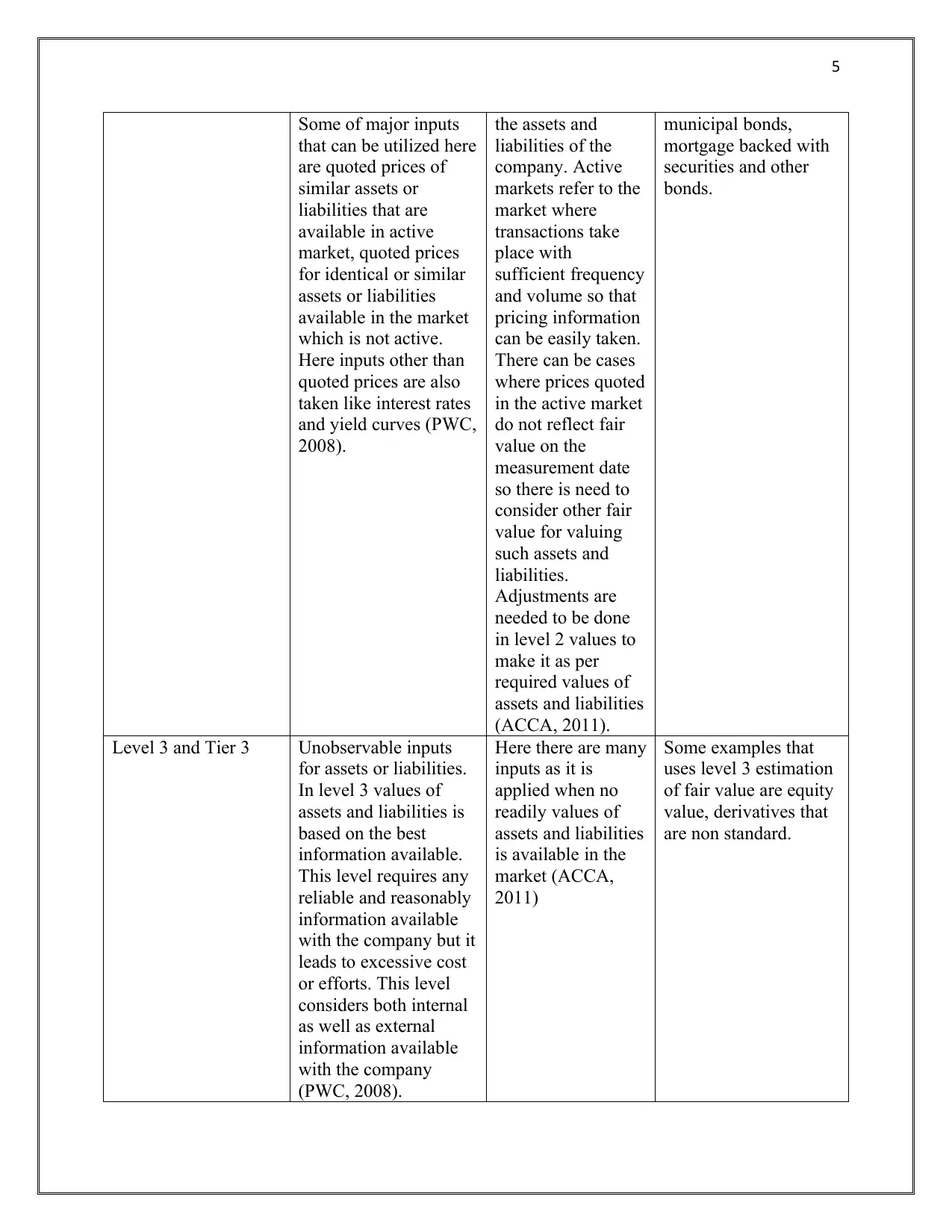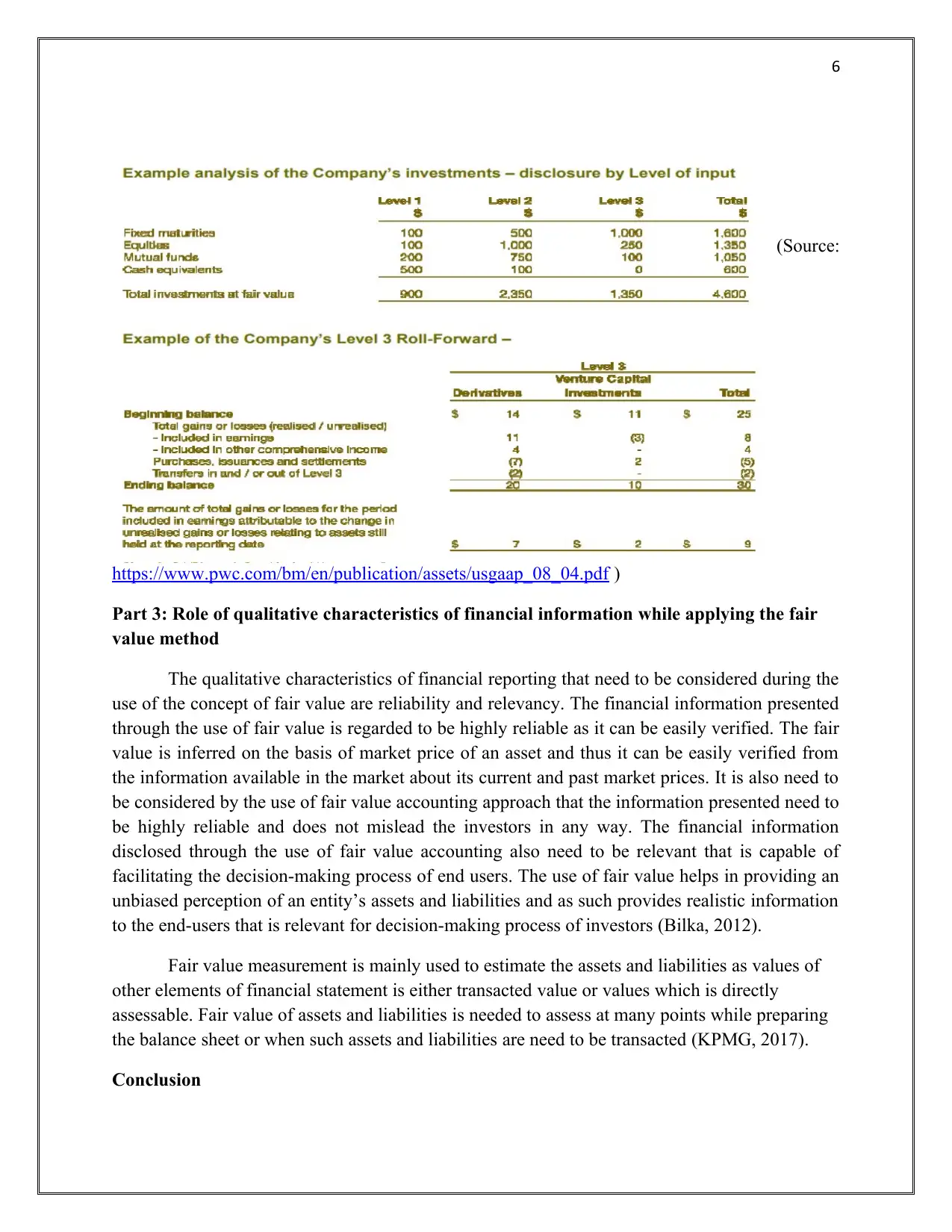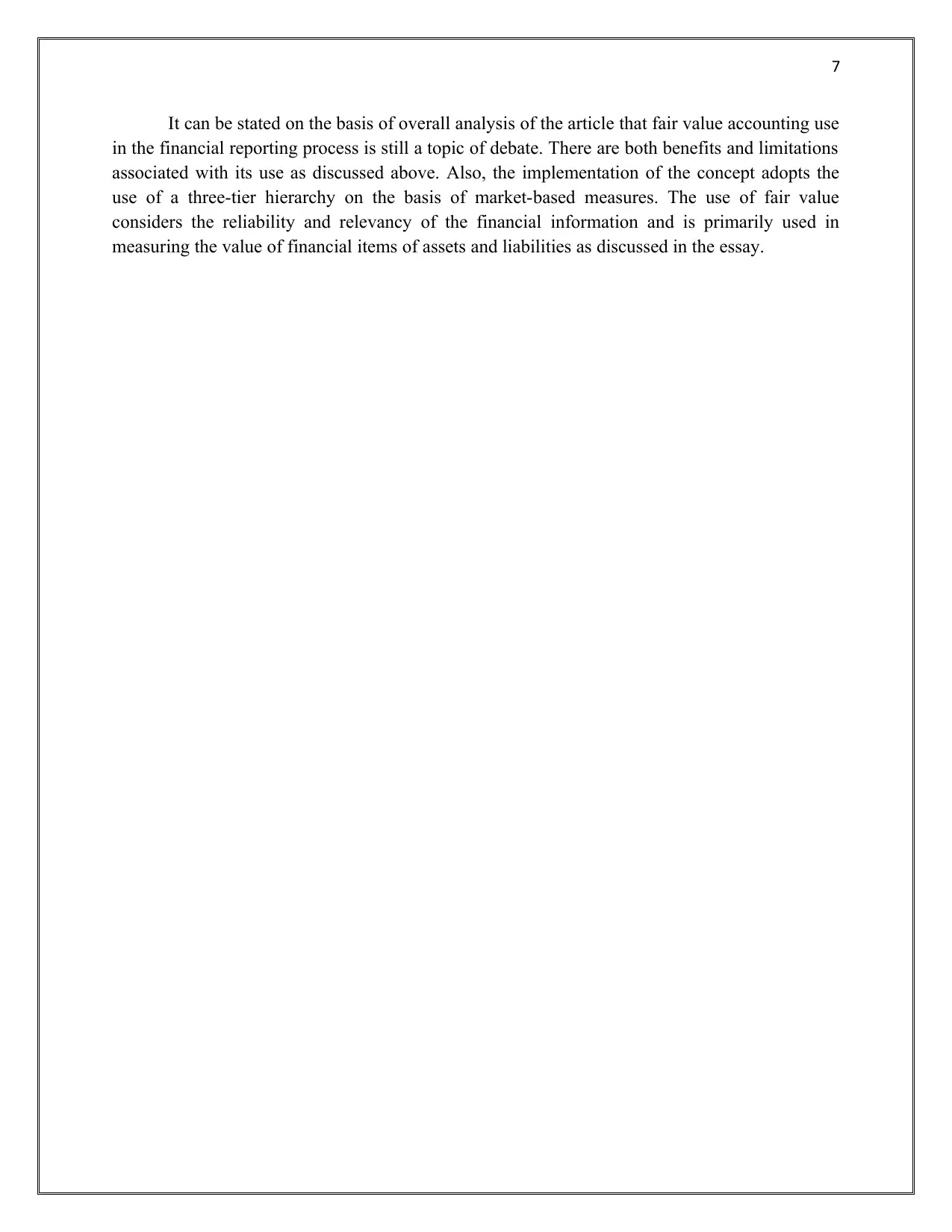ACCT6007 Financial Accounting: Fair Value Analysis and Critical Review
VerifiedAdded on 2023/05/29
|8
|1851
|325
Report
AI Summary
This report presents a critical review of an article by Antonia Marra (2016) on fair value accounting, examining its role in financial statements. The report begins by outlining the advantages and disadvantages of fair value accounting, highlighting its relevance in providing current market-based information but also acknowledging potential manipulation and reliability issues, particularly during the 2008 financial crisis. The analysis then delves into the three-tier process or hierarchy of fair value measurement, explaining the levels and inputs used to determine fair value. Finally, the report discusses the significance of qualitative characteristics of financial information, specifically reliability and relevancy, when applying the fair value method. The conclusion summarizes the ongoing debate surrounding fair value accounting and its application in financial reporting, emphasizing its market-based measurement approach and the importance of considering both benefits and limitations.

1
ACCT6007 Financial Accounting Theory and Practice
ACCT6007 Financial Accounting Theory and Practice
Paraphrase This Document
Need a fresh take? Get an instant paraphrase of this document with our AI Paraphraser

2

3
Introduction
The underlying essay is undertaken for presenting a critical review of the article is written
by Antonia Marra and published in the year 2016. This article provides the information on fair
value of accounting and how it helps in valuing the elements of financial statements. It also
discusses the pro and cons of fair value measurement in the global accounting. The critical
review is undertaken by explaining the advantages and disadvantages of fair value accounting
(FV) accounting. This is followed by explaining the three-tier process in detail that is discussed
within the article. In addition to this, the qualitative characteristics of financial information to be
considered using FV method in financial reporting are also discussed within the report.
Part 1: Pros and Cons of Fair Value (FV) Accounting
The concept of FV measurement has been introduced by the IASB and it is used while
preparing the financial reports for the company. It helps in improving the reliability of the
financial information disclosed to the end-users. The application of FV enables the companies to
identify and measure estimated values of assets and liabilities on the balance sheet date so that
their fair market price can be reflected. It helps to provide the true and fair picture of financial
statement. However, the concept is associated with larger debate since its origin due to the
significant benefits and drawbacks that are associated with its use. The major benefit derived by
the companies with the use of fair value accounting approach is that it provides most relevant
information as per the current market conditions. It helps in providing realistic information to
the end-users as also stated in the given article. The fair value measures the value of an asset or
liability as per the market conditions and this makes the information disclosed to be verifiable
from the available market information. Thus, the financial experts have stated that this
accounting approach helps in improving the transparency within the financial reporting and
facilitates the investors for making accurate decisions.
However, the occurrence of the global financial crisis in the year 2008 have highlighted
various criticism associated with this concept. It has been pointed out by various accounting
experts that the use of this approach enabled the business managers for manipulating the
financial results (Marra, 2016). For example, the accounting scandal of Enron has revealed that
business executives have adopted the use of fair values for overstating revenue within the
company. In addition to this, the unavailability of the market price for a given asset can have an
impact on the reliability of the financial information obtained with the use of this concept. Also,
sometimes the observed amount of assets within the market does not provide required
fundamental value of such assets as per IFRS. The inefficiency present within the market can
lead to uncertainty within the fair value and thus resulting in providing misleading information
within the financial statements (Sundgren, 2013).
Part 2: Three tier process or three levels of fair value measurement
Introduction
The underlying essay is undertaken for presenting a critical review of the article is written
by Antonia Marra and published in the year 2016. This article provides the information on fair
value of accounting and how it helps in valuing the elements of financial statements. It also
discusses the pro and cons of fair value measurement in the global accounting. The critical
review is undertaken by explaining the advantages and disadvantages of fair value accounting
(FV) accounting. This is followed by explaining the three-tier process in detail that is discussed
within the article. In addition to this, the qualitative characteristics of financial information to be
considered using FV method in financial reporting are also discussed within the report.
Part 1: Pros and Cons of Fair Value (FV) Accounting
The concept of FV measurement has been introduced by the IASB and it is used while
preparing the financial reports for the company. It helps in improving the reliability of the
financial information disclosed to the end-users. The application of FV enables the companies to
identify and measure estimated values of assets and liabilities on the balance sheet date so that
their fair market price can be reflected. It helps to provide the true and fair picture of financial
statement. However, the concept is associated with larger debate since its origin due to the
significant benefits and drawbacks that are associated with its use. The major benefit derived by
the companies with the use of fair value accounting approach is that it provides most relevant
information as per the current market conditions. It helps in providing realistic information to
the end-users as also stated in the given article. The fair value measures the value of an asset or
liability as per the market conditions and this makes the information disclosed to be verifiable
from the available market information. Thus, the financial experts have stated that this
accounting approach helps in improving the transparency within the financial reporting and
facilitates the investors for making accurate decisions.
However, the occurrence of the global financial crisis in the year 2008 have highlighted
various criticism associated with this concept. It has been pointed out by various accounting
experts that the use of this approach enabled the business managers for manipulating the
financial results (Marra, 2016). For example, the accounting scandal of Enron has revealed that
business executives have adopted the use of fair values for overstating revenue within the
company. In addition to this, the unavailability of the market price for a given asset can have an
impact on the reliability of the financial information obtained with the use of this concept. Also,
sometimes the observed amount of assets within the market does not provide required
fundamental value of such assets as per IFRS. The inefficiency present within the market can
lead to uncertainty within the fair value and thus resulting in providing misleading information
within the financial statements (Sundgren, 2013).
Part 2: Three tier process or three levels of fair value measurement
⊘ This is a preview!⊘
Do you want full access?
Subscribe today to unlock all pages.

Trusted by 1+ million students worldwide

4
Fair value accounting is typically based on market based measures and it is regarded as
its governing principle to measure the value of elements of financial statements.
The assumption that is taken to value the fair value elements is that date for market prices
are being taken from various market participants that are active. In this way it is easy to estimate
the fair value of different elements of financial statement and it is more reliable than the internal
estimates. So, it can be said that market price provides the best estimate of fair value if the
market prices of such elements are effectively available and it is easy to calculate. This is the
reason why the fair value hierarchy has been divided into three levels of three tiers. Among these
levels the fair value hierarchy prioritizes the inputs used to calculate the fair value of different
elements (PWC, 2008). For example, in level 1 or tier 1, quoted prices available in active market
is taken and in level 3 or tier 3 the unobservable inputs is taken. Fair value hierarchy can be
understood in detail from the below table:
Fair Value Hierarchy or Three Tiers of Fair value Accounting
Levels of tiers Inputs taken or values
taken
Explanation Example
Level 1 or Tier 1 Under this some of
major inputs taken are
observable values,
values that are quoted
for identical assets and
same for liabilities as it
is available in the
active market (PWC,
2008)
It is important for
entities to first
consider the level 1
inputs that are
unadjusted quoted
prices available
from the active
markets for
identical assets or
liabilities that are
being measured. So
while applying
IFRS, if there is
quoted price of
identical assets or
liabilities is
available in the
active market than
that un-adjustable
quoted price is used
for fair value of
such assets or
liabilities (ACCA,
2011).
There are examples of
level 1 fair value
measurements like
prices quoted on the
stock exchange. Only
the management need
to adjust the price as
per the measurement
date and it is directly
assessable as the fair
value of respective
assets or liabilities.
There are many other
examples such as
securities of Australian
Government, securities
of various agencies,
debt issued by the
foreign agencies and
government etc.
Level 2 or Tier 2 There are many inputs
that can be utilized here
as fair value
measurement inputs.
In this case both
active market and
inactive market are
considered to value
There can be many
examples of level 2
measurement values
such as bank loans,
Fair value accounting is typically based on market based measures and it is regarded as
its governing principle to measure the value of elements of financial statements.
The assumption that is taken to value the fair value elements is that date for market prices
are being taken from various market participants that are active. In this way it is easy to estimate
the fair value of different elements of financial statement and it is more reliable than the internal
estimates. So, it can be said that market price provides the best estimate of fair value if the
market prices of such elements are effectively available and it is easy to calculate. This is the
reason why the fair value hierarchy has been divided into three levels of three tiers. Among these
levels the fair value hierarchy prioritizes the inputs used to calculate the fair value of different
elements (PWC, 2008). For example, in level 1 or tier 1, quoted prices available in active market
is taken and in level 3 or tier 3 the unobservable inputs is taken. Fair value hierarchy can be
understood in detail from the below table:
Fair Value Hierarchy or Three Tiers of Fair value Accounting
Levels of tiers Inputs taken or values
taken
Explanation Example
Level 1 or Tier 1 Under this some of
major inputs taken are
observable values,
values that are quoted
for identical assets and
same for liabilities as it
is available in the
active market (PWC,
2008)
It is important for
entities to first
consider the level 1
inputs that are
unadjusted quoted
prices available
from the active
markets for
identical assets or
liabilities that are
being measured. So
while applying
IFRS, if there is
quoted price of
identical assets or
liabilities is
available in the
active market than
that un-adjustable
quoted price is used
for fair value of
such assets or
liabilities (ACCA,
2011).
There are examples of
level 1 fair value
measurements like
prices quoted on the
stock exchange. Only
the management need
to adjust the price as
per the measurement
date and it is directly
assessable as the fair
value of respective
assets or liabilities.
There are many other
examples such as
securities of Australian
Government, securities
of various agencies,
debt issued by the
foreign agencies and
government etc.
Level 2 or Tier 2 There are many inputs
that can be utilized here
as fair value
measurement inputs.
In this case both
active market and
inactive market are
considered to value
There can be many
examples of level 2
measurement values
such as bank loans,
Paraphrase This Document
Need a fresh take? Get an instant paraphrase of this document with our AI Paraphraser

5
Some of major inputs
that can be utilized here
are quoted prices of
similar assets or
liabilities that are
available in active
market, quoted prices
for identical or similar
assets or liabilities
available in the market
which is not active.
Here inputs other than
quoted prices are also
taken like interest rates
and yield curves (PWC,
2008).
the assets and
liabilities of the
company. Active
markets refer to the
market where
transactions take
place with
sufficient frequency
and volume so that
pricing information
can be easily taken.
There can be cases
where prices quoted
in the active market
do not reflect fair
value on the
measurement date
so there is need to
consider other fair
value for valuing
such assets and
liabilities.
Adjustments are
needed to be done
in level 2 values to
make it as per
required values of
assets and liabilities
(ACCA, 2011).
municipal bonds,
mortgage backed with
securities and other
bonds.
Level 3 and Tier 3 Unobservable inputs
for assets or liabilities.
In level 3 values of
assets and liabilities is
based on the best
information available.
This level requires any
reliable and reasonably
information available
with the company but it
leads to excessive cost
or efforts. This level
considers both internal
as well as external
information available
with the company
(PWC, 2008).
Here there are many
inputs as it is
applied when no
readily values of
assets and liabilities
is available in the
market (ACCA,
2011)
Some examples that
uses level 3 estimation
of fair value are equity
value, derivatives that
are non standard.
Some of major inputs
that can be utilized here
are quoted prices of
similar assets or
liabilities that are
available in active
market, quoted prices
for identical or similar
assets or liabilities
available in the market
which is not active.
Here inputs other than
quoted prices are also
taken like interest rates
and yield curves (PWC,
2008).
the assets and
liabilities of the
company. Active
markets refer to the
market where
transactions take
place with
sufficient frequency
and volume so that
pricing information
can be easily taken.
There can be cases
where prices quoted
in the active market
do not reflect fair
value on the
measurement date
so there is need to
consider other fair
value for valuing
such assets and
liabilities.
Adjustments are
needed to be done
in level 2 values to
make it as per
required values of
assets and liabilities
(ACCA, 2011).
municipal bonds,
mortgage backed with
securities and other
bonds.
Level 3 and Tier 3 Unobservable inputs
for assets or liabilities.
In level 3 values of
assets and liabilities is
based on the best
information available.
This level requires any
reliable and reasonably
information available
with the company but it
leads to excessive cost
or efforts. This level
considers both internal
as well as external
information available
with the company
(PWC, 2008).
Here there are many
inputs as it is
applied when no
readily values of
assets and liabilities
is available in the
market (ACCA,
2011)
Some examples that
uses level 3 estimation
of fair value are equity
value, derivatives that
are non standard.

6
(Source:
https://www.pwc.com/bm/en/publication/assets/usgaap_08_04.pdf )
Part 3: Role of qualitative characteristics of financial information while applying the fair
value method
The qualitative characteristics of financial reporting that need to be considered during the
use of the concept of fair value are reliability and relevancy. The financial information presented
through the use of fair value is regarded to be highly reliable as it can be easily verified. The fair
value is inferred on the basis of market price of an asset and thus it can be easily verified from
the information available in the market about its current and past market prices. It is also need to
be considered by the use of fair value accounting approach that the information presented need to
be highly reliable and does not mislead the investors in any way. The financial information
disclosed through the use of fair value accounting also need to be relevant that is capable of
facilitating the decision-making process of end users. The use of fair value helps in providing an
unbiased perception of an entity’s assets and liabilities and as such provides realistic information
to the end-users that is relevant for decision-making process of investors (Bilka, 2012).
Fair value measurement is mainly used to estimate the assets and liabilities as values of
other elements of financial statement is either transacted value or values which is directly
assessable. Fair value of assets and liabilities is needed to assess at many points while preparing
the balance sheet or when such assets and liabilities are need to be transacted (KPMG, 2017).
Conclusion
(Source:
https://www.pwc.com/bm/en/publication/assets/usgaap_08_04.pdf )
Part 3: Role of qualitative characteristics of financial information while applying the fair
value method
The qualitative characteristics of financial reporting that need to be considered during the
use of the concept of fair value are reliability and relevancy. The financial information presented
through the use of fair value is regarded to be highly reliable as it can be easily verified. The fair
value is inferred on the basis of market price of an asset and thus it can be easily verified from
the information available in the market about its current and past market prices. It is also need to
be considered by the use of fair value accounting approach that the information presented need to
be highly reliable and does not mislead the investors in any way. The financial information
disclosed through the use of fair value accounting also need to be relevant that is capable of
facilitating the decision-making process of end users. The use of fair value helps in providing an
unbiased perception of an entity’s assets and liabilities and as such provides realistic information
to the end-users that is relevant for decision-making process of investors (Bilka, 2012).
Fair value measurement is mainly used to estimate the assets and liabilities as values of
other elements of financial statement is either transacted value or values which is directly
assessable. Fair value of assets and liabilities is needed to assess at many points while preparing
the balance sheet or when such assets and liabilities are need to be transacted (KPMG, 2017).
Conclusion
⊘ This is a preview!⊘
Do you want full access?
Subscribe today to unlock all pages.

Trusted by 1+ million students worldwide

7
It can be stated on the basis of overall analysis of the article that fair value accounting use
in the financial reporting process is still a topic of debate. There are both benefits and limitations
associated with its use as discussed above. Also, the implementation of the concept adopts the
use of a three-tier hierarchy on the basis of market-based measures. The use of fair value
considers the reliability and relevancy of the financial information and is primarily used in
measuring the value of financial items of assets and liabilities as discussed in the essay.
It can be stated on the basis of overall analysis of the article that fair value accounting use
in the financial reporting process is still a topic of debate. There are both benefits and limitations
associated with its use as discussed above. Also, the implementation of the concept adopts the
use of a three-tier hierarchy on the basis of market-based measures. The use of fair value
considers the reliability and relevancy of the financial information and is primarily used in
measuring the value of financial items of assets and liabilities as discussed in the essay.
Paraphrase This Document
Need a fresh take? Get an instant paraphrase of this document with our AI Paraphraser

8
References
ACCA. 2011. How to measure fair value. Retrieved on November 16, 2018, from
https://www.accaglobal.com/in/en/member/discover/cpd-articles/corporate-reporting/
measure-value.html
Bilka, P. (2012). Fair Value in Financial Statements – Advantages and Disadvantages.
Economics Series 22(2), 1-8.
KPMG. 2017. Statement of Financial Accounting Standards No. 157 – Fair Value
Measurements. Retrieved on November 16, 2018, from
https://home.kpmg.com/content/dam/kpmg/xx/pdf/2017/12/fair-value-qa-2017.pdf
Marra, A. (2016). The Pros and Cons of Fair Value Accounting in a Globalized Economy: A
Never Ending Debate. Journal of Accounting, Auditing & Finance 31(4), 582–591.
PWC. 2008. Statement of Financial Accounting Standards No. 157 – Fair Value Measurements.
Retrieved on November 16, 2018, from
https://www.pwc.com/bm/en/publication/assets/usgaap_08_04.pdf
Sundgren, S. 2013. Is fair value accounting really fair? A discussion of pros and cons with fair
value measurement. Retrieved 16 November, 2018, from
http://lta.lib.aalto.fi/2013/3-4/lta_2013_03-4_d5.pdf
References
ACCA. 2011. How to measure fair value. Retrieved on November 16, 2018, from
https://www.accaglobal.com/in/en/member/discover/cpd-articles/corporate-reporting/
measure-value.html
Bilka, P. (2012). Fair Value in Financial Statements – Advantages and Disadvantages.
Economics Series 22(2), 1-8.
KPMG. 2017. Statement of Financial Accounting Standards No. 157 – Fair Value
Measurements. Retrieved on November 16, 2018, from
https://home.kpmg.com/content/dam/kpmg/xx/pdf/2017/12/fair-value-qa-2017.pdf
Marra, A. (2016). The Pros and Cons of Fair Value Accounting in a Globalized Economy: A
Never Ending Debate. Journal of Accounting, Auditing & Finance 31(4), 582–591.
PWC. 2008. Statement of Financial Accounting Standards No. 157 – Fair Value Measurements.
Retrieved on November 16, 2018, from
https://www.pwc.com/bm/en/publication/assets/usgaap_08_04.pdf
Sundgren, S. 2013. Is fair value accounting really fair? A discussion of pros and cons with fair
value measurement. Retrieved 16 November, 2018, from
http://lta.lib.aalto.fi/2013/3-4/lta_2013_03-4_d5.pdf
1 out of 8
Related Documents
Your All-in-One AI-Powered Toolkit for Academic Success.
+13062052269
info@desklib.com
Available 24*7 on WhatsApp / Email
![[object Object]](/_next/static/media/star-bottom.7253800d.svg)
Unlock your academic potential
Copyright © 2020–2025 A2Z Services. All Rights Reserved. Developed and managed by ZUCOL.




